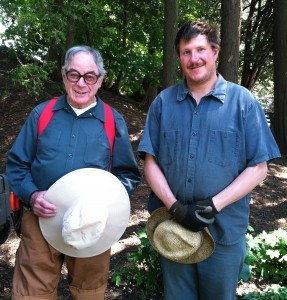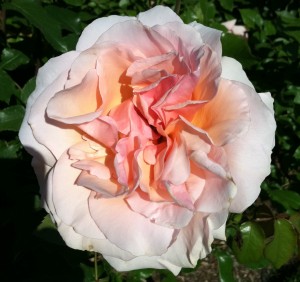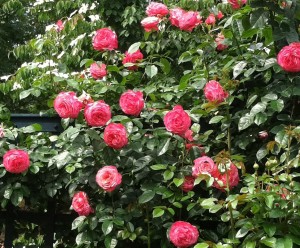Life is Rosy: Gene Sekulow
Posted in Around the Garden on June 19 2012, by Sonia Uyterhoeven
Sonia Uyterhoeven is the NYBG’s Gardener for Public Education.

Tuesdays on Plant Talk are generally a time for me to voice my opinions on what we have growing in our plant paradise at The New York Botanical Garden. From time to time, however, I like to interview my colleagues and badger them on their areas of expertise. Today, I am going to share with you a discussion I had with Gene Sekulow–one of the wonderful volunteers helping us to keep the Peggy Rockefeller Rose Garden growing beautifully.
I first asked Gene to name his favorite rose, and on this topic he waxed lyrical. His favorite bloom in the garden is a 2006 Meilland grandiflora introduction named ‘Mother of Pearl’. He likened the pale pink blossom on the rose to the color of Meggie Cleary’s evening dress in The Thorn Birds. For those of you with a penchant for sentimentality, this is the scene when Meggie glides down the stairs and the besotted priest, Father Ralph de Bricassart, realizes that she is no longer a child but a woman. The dress was a rose dress–as Father Ralph describes, “ashes of roses.”

‘Mother of Pearl’ is a highly disease-resistant cultivar that grows four to six feet tall, has heavy, lustrous green foliage, and a subtle fragrance. A top performer, she holds a prominent spot in the Rose Garden, situated close to the pergola in the center of the collection. The hybridizer of the rose, Alain Meilland, is one of France’s top rosarians–known for his disease-resistant roses.
Gene’s favorite climbing rose comes from the equally illustrious German hybridizers, Kordes. His chosen climber is named ‘Rosanna’. She has salmon-pink double flowers with luxuriant green foliage, along with a faint fragrance reminiscent of rose water. Like ‘Mother of Pearl’, ‘Rosanna’ flowers repeatedly throughout the summer.
I asked Gene about the most common question he hears while working in the rose garden. “‘I love roses, but they are too much trouble to grow,'” he repeated. His refrain to the visitors: “Then you are growing the wrong rose.”
Gene explained that if you are growing the right rose, in the right soil, with the right amount of sun and water, then you should be able to grow your roses without too much of a fuss. He spoke about the Earth-Kind® Trial beds that I blogged about last week. His mantra: “Avoid chemicals that kill the soil’s natural biology,” and add organic matter to the soil.
In the Peggy Rockefeller Rose Garden, Gene explained that they feed the roses with a combination of Rose-tone® and Epsom salts at a ratio of approximately 3:1. The magnesium in the Epsom salts helps the plants take up the nutrients and encourages basal breaks (growth from the base of the rose).

In a discussion on the pros and cons of organic versus inorganic fertilizer, Gene made a wonderful analogy that will stay with me. Inorganic fertilizer, he said, is like force-feeding a plant in the same way you force feed a goose to produce foie gras. Organic fertilizer, on the other hand, gets taken up by the plant when it needs it.
For humanitarian reasons, perhaps many of us will start fertilizing our roses organically. No one wants to think that they are cramming nutrients down a rose’s throat. What a waste… and that’s not to mention the environmental repercussions of the excess chemicals leaching into the ground water. But, of course, life is never so simple: I for one have always fertilized my roses organically, but exercise a double standard when it comes to pâté.
If you are down in the Peggy Rockefeller Rose Garden on a Tuesday or a Friday, make sure you stop and say hello to Gene. He is easy to find and full of amiable advice for the hopeful rosarian.

